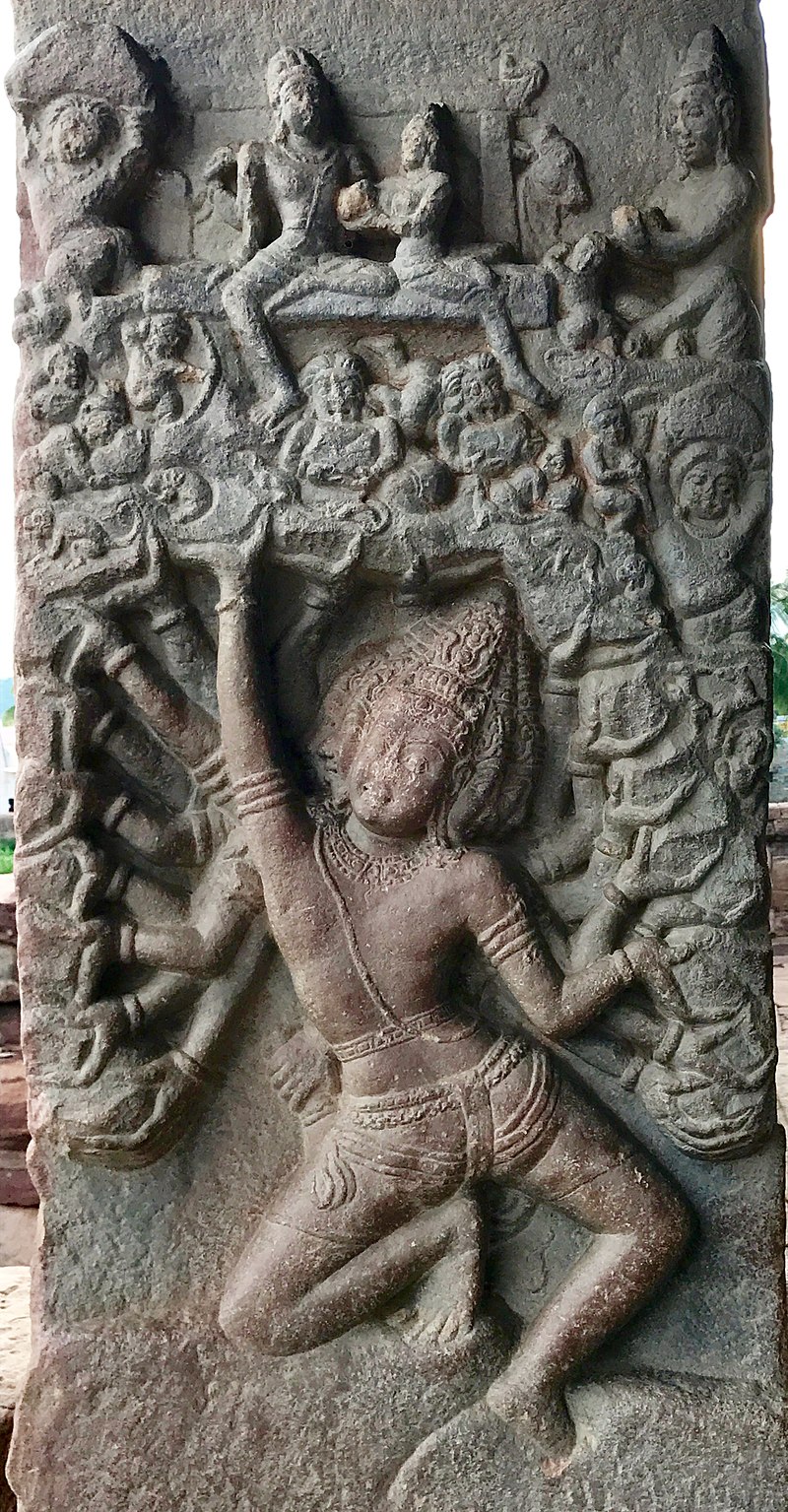According to Hindu mythology, Satya Yuga signals the era during which the gods and intrinsic goodness ruled humanity, and at the end of his labors, the creator god, Brahma, sleeps. But during his deep slumber, Brahma’s breath created enormous, blood-thirsty fanged creatures with sharp, claw-like fingernails. Growling like beasts, these creatures turned upon Brahma and began devouring him. Brahma woke and shouted “Rakshama!” (Protect me!) and Vishnu, the god of protection and the preserver of good, came to his aid and banished all these strange creatures to earth. These creatures were then known as Rakshasas, after Brahma’s cry for help.
Although they have the power to change their shape at will and appear as animals, monsters, or beautiful women, sculptures and literatures generally depict the Rakshasas with a terrifying appearance – fearful side tusks, ugly eyes, curling brows and carrying a variety of horrible weapons – thus establishing them as the antagonists of the epics and traditional opponents of the heroes.

12th century, Heian Period
But, as with everything else in life, not all Rakshasas are ugly. In the Sundara Kanda, the fifth book of the Hindu epic Ramayana, Hanuman describes the Rakshasa women as ‘beautiful, moon-faced, radiant and lotus-eyed’. Searching for Sita in the palaces of Laṅka, Hanuman even mistook Mandodari, a Rakshasi (female Rakshasa) as well as the wife of the Rakshasa king Ravana, for Sita herself. Evidently, Hanuman perceived Mandodari as a beautiful woman.
Just as not all Rakshasas are equally ugly, not all Rakshasas are equally evil. As warriors, the Rakshasas fought alongside the armies of both good and evil. In chapter 26 of the Lotus Sutra, which is one of the most popular and influential Mahayana sutras as well as the basis on which many schools of Buddhism were established, includes a dialogue between the Buddha and a group of ten Rakshasis, who swear to uphold and protect the Lotus Sutra. These ten Rakshasis went before the Buddha and spoke to him in unison, saying: “World Honored One, we, too, wish to protect those who read, recite, receive, and hold the Dharma Flower Sutra, and keep them from harm.”

The Mahabharata tells us about the journey of Bhima, the second of the five Pandava brothers, who became a prolific slayer of Rakshasas. Bhima’s career began when he, with his mother and brothers, travelled into a dark forest overrun with man-eating demons. Although the company went along peacefully during the day, they were immediately targeted by a vicious Rakshasa named Hidimba when they laid down to sleep under the forest canopy at night. Determined to eat them, Hidimba sent his sister, Hidimbi, to gather more information about their weapons and sleeping arrangements. However, when Hidimbi went into the Pandava brothers’ camp and saw Bhima, she instantly fell in love with him. As Hidimbi warned Bhima about her brother’s plan, when Hidimba attacked, Bhima was ready to meet him. The Rakshasa was dead in no time leaving Hidimbi without any family. Desperate, Hidimbi begged Bhima to marry her, and which he finally consented after being repeatedly persuaded by Hidimbi herself as well as his own mother Kunti. The marriage only lasted for a short time, but enough for Hidimbi to eventually bore Bhima a son, Ghatotkacha. When the Pandavas left the forest, Bhima joined his brothers as they were on a war campaign thereby leaving Hidimbi to raise his son as a single mother.

Hidimbi apparently raised his son well. Ghatotkacha grew up to be a fine warrior, as well as a loyal and humble figure. Ghatotkacha and his followers were available to his father Bhima at any time, to such an extent that all Bhima had to do was to think of him and he would appear. Later, Ghatotkacha was summoned by Bhima to fight on the Pandava side in the Kurukshetra War. Invoking the magical powers he inherited from his mother, Ghatotkacha wrought great havoc in the Kaurava army particularly when the battle continued on past sunset when, being a Rakshasa himself, Ghatotkacha’s powers were at their most effective. Knowing that the entire Kaurava army was near annihilation through Ghatotkacha’s ceaseless strikes from the air, the Kaurava leader Duryodhana appealed to his best fighter, Karna, to kill Ghatotkacha. A temple in Manali, Himachal Pradesh, honors Ghatotkacha and is located near the Hidimba Devi Temple.

Although he was not an effective partner and father, Bhima’s treatment of Hidimbi was considerably kinder than how Lakshmana, the brother of Rama in the Ramayana, treated the Rakshasi who loved him. Shurpanakha, a widowed Rakshasi sister of the king of Lanka, Ravana, split her time between Lanka and the woods. One day, when she met Rama and Lakshmana in their travels, she fell in love with Lakshmana and asked him to be her husband. Lakshmana not only rejected Shurpanakha because of her looks and background, but he also punished her for daring to ask him for marriage by cutting off her nose and ears.
In the Ramayana, when the revered Rishi Agastaya cursed the demon prince Sunda to death, Tadaka took it upon herself to wreak vengeance on the sage with the help of her son Subahu. Agastya then cursed Tadaka with the loss of her beautiful appearance and transformed the mother and son into Rakshasas. After this curse, Tadaka and Subahu started living in a forest near the River Ganga. Never forgetting what Agastaya has done to them, Tadaka and Subahu attempted to harass as many rishis as they could, by destroying their yagnas (offerings) with rains of flesh and blood. This continued until Dasaratha, the King of Kosala, sent two of his sons (the still very young Rama and Lakshmana) to the forest to protect the rishi Vishwamitra and his yagna.

Vishwamitra and the two princes came to the forest and Vishwamitra ordered Rama to kill Tadaka to free the area from her terror. As Tadaka was a woman, Rama was hesitant to kill her. Therefore, he only maimed her by chopping off her hands so that she could not attack him further. However, using her magical powers, Tadaka disappeared and continued to attack them while remaining invisible. Vishwamitra told Rama that, as a prince, he had to fulfill his duty despite his personal reservations about killing a woman. Resolved by this, Rama swiftly pierced Tadaka’s heart with his arrows and killed her.

This resolve helped Rama later in life as the battle of Lanka pitted an army of Rakshasa, led by Ravana, against an army of Vanaras (monkeys) led by Rama and the monkey king Sugriva. Ravana was the ten-headed Rakshasa King of Lanka. In book III of the Mahabharata, the sage Markandeya tells the story of how Ravana kidnapped Rama’s wife Sita and whisked her off to his kingdom. Although Hindu mythology portrays the Rakshasas as cannibals, Ravana did not try to eat Sita while she was captive in Lanka. According to the Vedic text Srimad Bhagavatam, Ravana was not actually evil. He was the gatekeeper of Vaikuntha (the spiritual realm where there is no suffering) who was cursed to be born in the material world. When Ravana became the king of Lanka, he convinced Lord Brahma to make him immortal – Ravana’s condition was that he could only be killed by the hand of a human since he never believed that a human would possess the power to kill him. Ravana’s reason for abducting Sita was to avenge the humiliation of his sister, Shurpanakha, at the hand of Lakshmana who cut off her ears and nose as a punishment for her desperate wish to marry him. After Sita’s abduction, Rama and Lakshmana went to Lanka and, with the help of Sugriva and his army of monkeys, fought a bloody war with the Ravana and his Rakshasas. Finally, Rama and his men freed Sita and destroyed almost every able-bodied Rakshasa in the kingdom of Lanka, including Ravana himself.

Vibhishana, Ravana’s younger brother, was considered beautiful, pious and assiduous in his religious observances. When Brahma granted him a boon, Vibhishana asked for the ability to never swerve from the path of righteousness and to always be illumined by divine knowledge. Vibhishana joined Rama in his battle against Ravana and helped Rama’s army to cross the ocean into Lanka. When invisible Rakshasas infiltrated Rama’s camp, Vibhishana was the one who made them become visible again and enabled Rama’s monkey soldiers to destroy them. After Rama’s final victory over Ravana, Vibhishana was made king of Lanka and the remaining Rakshasas.

Another one of Ravana’s brother was Kumbhakarna. Unlike, his brother Ravana who asked Brahma for immortality, or Vibhishana who asked Brahma for divine knowledge, Kumbhakarna’s wish to from Brahma was simple. His request was for a long-lasting sleep. Although he was a fearsome warrior and master of illusion, Kumbhakarna slept through most of the Battle of Lanka. When Ravana awakened him with about the conflict, Kumbhakarna woke up and took the field. Upon marching out of the city, Kumbhakarna was immediately swarmed by Rama’s monkeys. However, he just laughed and wreaked havoc among them. When the powerful monkey king Sugriva attacked, Kumbhakarna dragged him off. Rama and Lakshmana used arrows and a secret Brahmastra (Brahma’s weapon) to kill Kumbhakarna.
